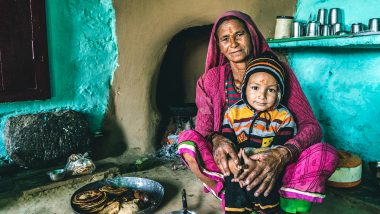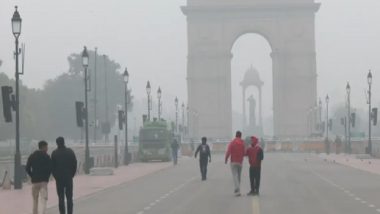Ranchi, Oct 15: For years, 48-year-old Suman Verma Kujra cooked food for her seven-member family using solid fuels, mostly wood, in her kitchen in Jharkhand's Lohardaga district.
Kujra, a resident of Hendlaso village, about 80 km from here, experienced health difficulties, such as eye inflammation and respiratory issues, due to smoke emanating from chulha (oven) in her kitchen having an asbestos roof. But, she thought it was normal, and every kitchen functions this way.
Till then, the woman had been ignorant about household air pollution and its impact on health. “I never heard that smoke coming out of chulhas is not good for health and it can cause multiple diseases,” Kujra told PTI.
However, the housewife's perception changed after she attended a programme on air pollution and climate change on December 2, 2020, organised by a Jharkhand-based NGO, where she came to know for the first time about household air pollution. Tamil Nadu Gas Leak: 67 Students of Krishnagiri School Recuperating in Hospital, Say Authorities.
“Later, we were trained on how to measure in-house air quality and ways to reduce the impact of pollution to some extent. We were also given an air quality monitoring device,” Kujra said. When she measured the air quality of her kitchen for the first time with such a device after burning the chulha, the count of fine particulate matter PM 2.5, a pollutant, was near about 900 ug/m3 as against the normal range of 40ug/m3.
“I was told that the range is very dangerous for health. In a bid to lower the pollution impact, I immediately constructed a window for proper ventilation in the kitchen and stopped burning plastics, papers in the chulha. At present, I use both LPG stove and chulha for cooking food,” she said. Kujra now runs a self-help group (SHG) under the Jharkhand State Livelihood Promotion Society (JSLPS), a nodal agency for the implementation of national rural livelihood mission (NRLM) projects.
“Since I am associated with SHG, I decided to create awareness about household air pollution among women in villages with the support of the NGO. Till now, I have reached out to around 400 women and they have also joined the campaign against pollution,” she said. A similar view was aired by Reena Oraon, a resident of Hariharpur village.
Oraon told PTI, “I was not aware of household pollution earlier. Now, I decided to build a kitchen outside the living room so that smoke goes out easily. I have also joined the mission to make people aware of health impacts due to air pollution in my village.” Household pollution, mainly in rural areas, is hardly discussed in seminars even though “its impact is huge on those who are cooking using fossil fuel,” said Manorama Ekka, the founder of HOPE, a civil society organisation. Diwali 2022: Fireworks Traders in West Bengal Seek Single-Window System for Trade Licence Nod.
“We mostly talk about various sources of air pollution such as factories and vehicles in urban areas. But there is hardly any discussion on household air pollution. We decided to wage a war against it and protect rural people from its impact,” she told PTI. Even though the government has provided LPG cylinders to villagers, this is “still not affordable for the majority of people in rural Jharkhand” due to their poor earning source, Ekka said.
“They are still using wood or coal to cook food, which causes huge pollution in households. The air quality readings that were taken near chulhas here have shown PM 2.5 ranging from 600 ug/m3 to 2000 ug/m3, which is many times above the normal level of 40ug/m3 stipulated by the Central Pollution Control Board,” she said. Till now, more than 4,000 women have been made aware of household air pollution in Lohardaga, and around 1,000 of them have already adopted the practices to lower pollution, Ekka said.
“We have started the mission from Lohardaga and now it is being extended to Bokaro and Dhanbad too. We encourage women to use smokeless chulhas, proper windows in the kitchen, or cooking in airy places,” she said.
Speaking about the impact on health, associate professor at the civil and environment department of BIT Mesra, Ranchi, Kirti Abhishek told PTI, “Burning of solid fuels such as wood releases carbon monoxide. When carbon monoxide is inhaled, carboxyhemoglobin (COHb) forms in red blood cells.”
He said that Carboxyhaemoglobin reduces the oxygen level in blood. Children are the worst affected by the situation. Besides, PM 2.5 causes several diseases such as asthma, lung disorder, and respiratory issues.
A recent study conducted by ASAR, an organisation that seeks to address the big environmental and social challenges facing India, and the Jharkhand-based NGO showed that there are several barriers in the way of women's access to clean cooking fuel. “While affordability of LPG is a key factor, problems related to door-to-door delivery of cylinders and socio-cultural issues concerning the use of chulhas also play a crucial role,” ASAR's gender and climate programme head Neha Saigal told PTI.
She called for a multi-pronged approach to address the issue. “It should include filling up the gaps in our current policies, subsidising clean fuel, and creating awareness through behaviour change campaigns, investing in research and development in the area to find affordable solutions such as solar-based cooking,” Saigal said.













 Quickly
Quickly




















